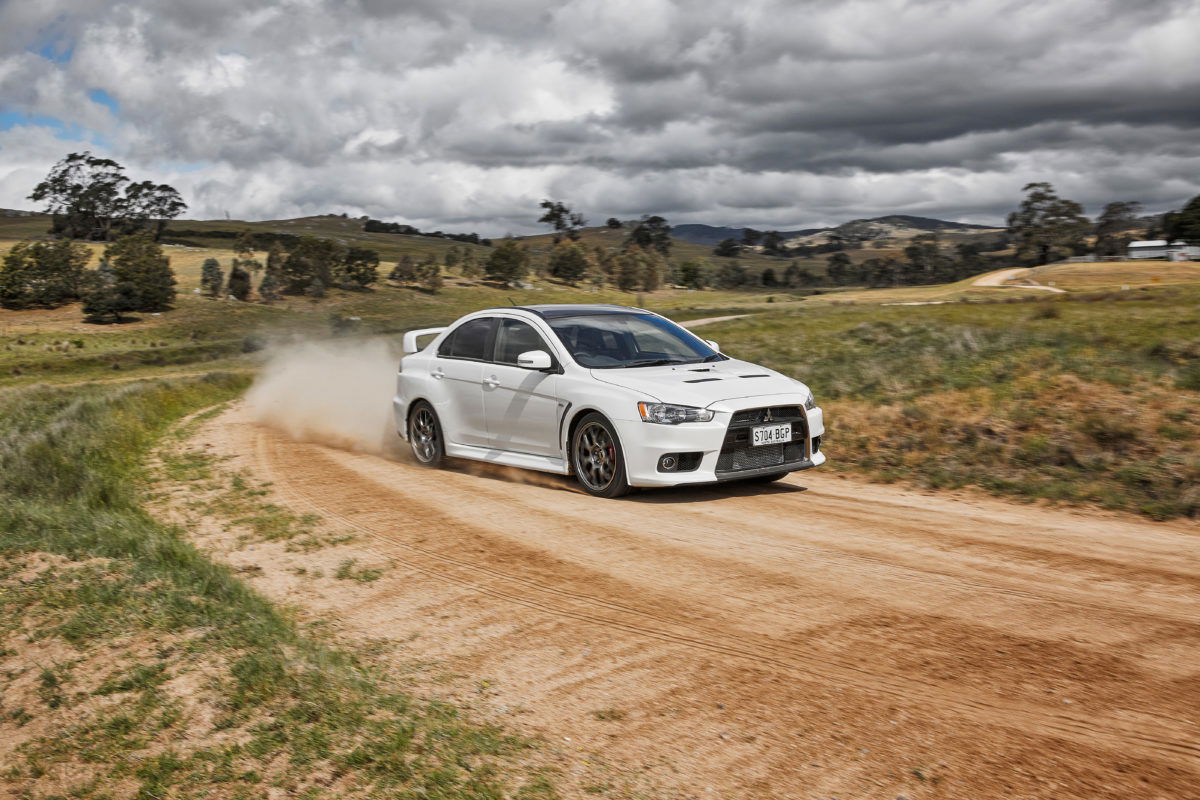We all, deep-down, want to be rally car drivers.
The ability to navigate your way through a tight, tree-lined road at high-speed is the ultimate driving skill. Unfortunately, few of us actually have that ability.
Which might explain why we flock to rally-inspired hot hatches and have done for decades. Subaru hasn’t competed at the top echelon of the sport for a decade and yet its WRX is still associated with Colin McRae and Petter Solberg leaping through the forest.
One of the reasons rally cars became so linked to road-going hot hatches was the move to Group A regulations in the 1980s, which forced car makers to compete with something from the showroom. That led to specially-created models that were designed with driving stages, rather than down to the shops, in mind.
Mitsubishi Lancer Evolution
 The Lancer Evolution (or Evo as it became better known) began life in 1992 when Mitsubishi needed a new car to tackle the World Rally Championship. The compact Lancer was stuffed full of a turbocharged engine and all-wheel drive to make it special stage ready.
The Lancer Evolution (or Evo as it became better known) began life in 1992 when Mitsubishi needed a new car to tackle the World Rally Championship. The compact Lancer was stuffed full of a turbocharged engine and all-wheel drive to make it special stage ready.
It didn’t take long for it to become successful and Mitsubishi kept upgrading it, creating the Evo II in ‘94, Evo III in ‘95 before the arrival of the Evo IV in ‘96 that really made its mark. Tommi Makinen used the Evo IV, V and VI to devastating effect, claiming four WRC titles on the trot from 1996 and ‘99.
By 2001 Mitsubishi had given up on the homologation specials required for Group A and built the next rally Lancer to the looser WRC rules of the day. That meant an end of the direct link between rally and road, but the Evo lived on until the 10th generation.
With the WRC program axed in 2006 and sales of the ageing Lancer dwindling around the world by 2010, the Lancer Evolution Final Edition of 2015 became its swansong.
Subaru WRX
 No list of great rally-inspired cars would be complete without the WRX – heck, it’s name literally stands for World Rally Experimental. Like the Lancer Evo (which was its arch-rival) the WRX began life as a humble Impreza small car but got baulked up by Subaru’s engineers in order to win rallies.
No list of great rally-inspired cars would be complete without the WRX – heck, it’s name literally stands for World Rally Experimental. Like the Lancer Evo (which was its arch-rival) the WRX began life as a humble Impreza small car but got baulked up by Subaru’s engineers in order to win rallies.
A turbocharged boxer engine, all-wheel drive and Colin McRae helped elevate the WRC to another level of popularity. In return the WRX helped change Subaru’s image from building cars to farmers to something more exciting and desirable.
Like the Mitsubishi, the end of Group A meant Subaru didn’t need to build the WRX for homologation purposes but it continued to do so anyway because it has become the halo model for the entire brand.
In fact, Subaru has ditched the Impreza branding in a bid to separate its performance car hero from its small car. An all-new model is due to arrive in the next two years and promises to stick to the same turbocharged, all-wheel drive heritage.
Hyundai i30 N
 Sure, Thierry Neuville and co. compete in the smaller, i20 Coupe but the link between what Hyundai has done in WRC and what you find in the showroom is obvious.
Sure, Thierry Neuville and co. compete in the smaller, i20 Coupe but the link between what Hyundai has done in WRC and what you find in the showroom is obvious.
The WRC program began almost simultaneously with the N Performance division, in fact, it spent several years rallying before the first i30 N hit the road.
Being the first performance car from the brand, it’s clear that the 2.0-litre turbocharged i30 N has benefited from some of the lessons learnt by the motorsport team.
It has a fun and engaging character that has made it one of the most popular hot hatches on sale today, despite the brand being new to the market.
Ford Fiesta ST
 The team at M-Sport has been a staple in WRC for decades, winning in a variety of Fords.
The team at M-Sport has been a staple in WRC for decades, winning in a variety of Fords.
There most recent steed has been based on the pint-sized Fiesta hatchback. Specifically the Ford Performance Fiesta ST, the latest example of which is set to arrive in Australia in 2020.
It will come in a five-door body (unlike the three-door WRC entry) and will be powered by a 1.5-litre three-cylinder turbocharged engine.
It may sound small on paper but with 147kW and 290Nm it should pack a punch. Plus all Australian-delivered Fiesta ST will be fitted with the Performance Package that’s an option overseas. That adds a mechanical limited-slip differential, launch control and force-vectoring springs.
Toyota Yaris GR-4
 Toyota was meant to celebrate Ott Tanak’s 2019 WRC crown by unveiling its first true hot hatch at Rally Australia. The unfortunate but unavoidable cancellation of the event means it’s not clear when the new Yaris GR-4 will have its public debut, but we already know it promises to be something special.
Toyota was meant to celebrate Ott Tanak’s 2019 WRC crown by unveiling its first true hot hatch at Rally Australia. The unfortunate but unavoidable cancellation of the event means it’s not clear when the new Yaris GR-4 will have its public debut, but we already know it promises to be something special.
While there’s no official information there’s some solid speculation that it will be packing a turbocharged engine, all-wheel drive, a wider body and more sophisticated suspension than the standard Yaris city runabout.
This is a big deal for Toyota, introducing a hot hatch to fill a hole in its line-up. It’s part of a bigger push to change its image from boring to fun with the help of Gazoo Racing – it’s motorsport division that is helping develop the likes of the Yaris GR-4 and the new Supra.













Discussion about this post